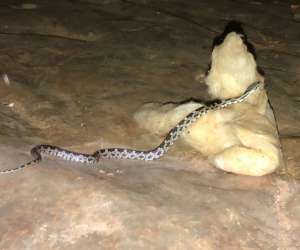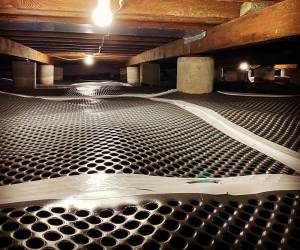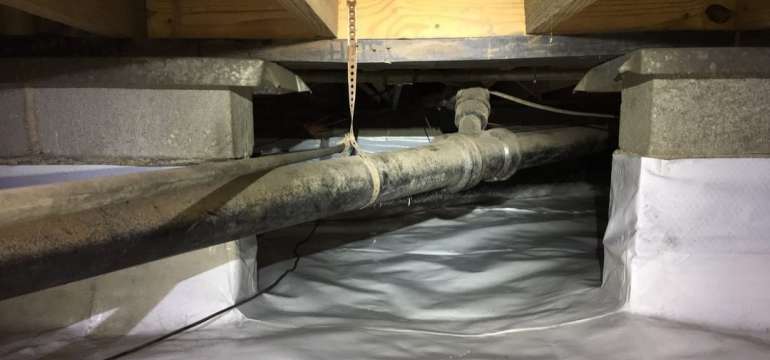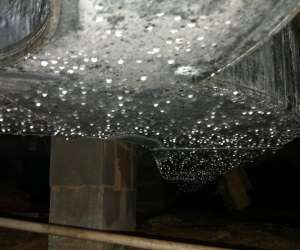Of the numerous projects you could do to improve the durability, longevity, and overall health and value of your home, crawl space encapsulation is one that is often overlooked. However, it can play an important role in the security and quality of your home’s underlying structure and foundation.
Let’s take a look at the concept, purpose, and processes of crawl space encapsulation. This way, you can have all the facts in hand before you make a final decision about whether or not crawl space encapsulation may be the right choice for your home.
Problems with Crawl Spaces
Crawl spaces are most often found underneath homes that do not have a full-sized basement and are not set directly onto a concrete foundation. They are low areas beneath the home that allow for some airflow and access to certain components and systems of the house. Ranch-style homes often have them, as do mobile homes. Occasionally you’ll find them underneath other styles and sizes of homes as well.
 Crawl spaces aren’t necessarily a positive thing. Their low ceiling and proximity to the ground make them tempting for pests, including anything from mice and rats to squirrels, possums, and skunks.
Crawl spaces aren’t necessarily a positive thing. Their low ceiling and proximity to the ground make them tempting for pests, including anything from mice and rats to squirrels, possums, and skunks.
Such creatures can take residence under the house at any time, so preventing their encroachment requires you to keep an eye on the status of your crawl space constantly. In addition to these creatures, you may be surprised to hear that some birds actually like nesting underneath homes with crawl spaces.
Crawl spaces can also become havens for stray cats, kittens, and dogs. Plus, bugs have full and easy access to the underside of your home, and they can find ways through the flooring into your house or infest the supports and joists.
 Due to lack of insulation underneath the house, some of the air conditioning or heating may leach out of the floor of the home into the air of the crawl space, reducing the home’s energy efficiency. If the area becomes clogged with vegetation, especially around the edges, airflow may be reduced, and that lack of proper ventilation can allow moisture to accumulate.
Due to lack of insulation underneath the house, some of the air conditioning or heating may leach out of the floor of the home into the air of the crawl space, reducing the home’s energy efficiency. If the area becomes clogged with vegetation, especially around the edges, airflow may be reduced, and that lack of proper ventilation can allow moisture to accumulate.
As you know, moisture accumulation in or near home is the perfect recipe for mildew, mold, and rot. And the worst part is that, unless you check underneath your home regularly, you may not even realize the problem is growing worse until you smell the mildew or until the rot becomes a risk to the integrity of your home’s flooring.
Crawl Space Encapsulation as a Solution
So is sealing a crawl space a good idea? It can be, depending on the method and purpose of it. Let’s look at a few of the benefits you may discover resulting from sealing or encapsulating your crawl space.
Crawl Space Encapsulation Cons
There is a lot of cost and effort involved in encapsulating a crawl space. When you’re considering crawl space pros and cons, it’s essential to get estimates for the materials and work required and to have a clear budget outlined.

You must have a great bases and the drainage matting liner is a must when the water table fluctuates so often.
True crawl space encapsulation extends beyond simply walling off the crawlspace with some wood or bricks. You need to think about conditioning the area as well since that’s the only thing that will truly solve the moisture problem. You’ll need airtight covers, flooring, and walls. And then, you’ll need to apply a heavy-duty plastic liner or some other form of vapor barrier to the floors and walls as well. Basically, you’re creating a basement with a very low ceiling.
As you’re working on the crawl space, keep in mind that you still need to invest in pest prevention. Consider how you can best shield the crawl space structure and your home’s support system from potential termite infestations. A termite barrier can be one solution to this, but thorough termite treatment isn’t just a one-time thing. It’s an ongoing cost, so keep that in mind as you move forward with the encapsulation project.
Crawl Space Encapsulation Pros
 Now that we have a clear picture of the problems that a crawl space can cause. Let’s consider the crawl space encapsulation pros that may make this home improvement choice worthwhile to you.
Now that we have a clear picture of the problems that a crawl space can cause. Let’s consider the crawl space encapsulation pros that may make this home improvement choice worthwhile to you.
Moisture Reduction

Condensation on the duct system in a crawl space.
In many crawlspaces where there is no insulation, heat or cool air can be lost, leaking from the house to the outside. And if there is insulation, it can eventually become filled with moisture and may mold and fall off in chunks.
Fortunately, crawl space encapsulation can resolve both of these issues. If you live in a humid area with a lot of rainfall and high moisture, definitely consider encapsulating your crawl space and thoroughly sealing and waterproofing it as well.
Pest Prevention
Closing in the crawlspace prevents bugs and insects from having unimpeded access to your home’s underbelly. It makes it a lot tougher for those creepy little pests to chew their way into the wood of your home or find crevices through which to slither into your house.
With an encapsulated crawl space, you’ll also have fewer worries about larger pests, such as rodents. You won’t have to fear the possibility that a family of possums or skunks may have moved in underneath your house.
Energy Efficiency
Even though you’re going to have to invest a significant amount of money in enclosing or encapsulating your crawlspace, you’ll find that you may make some of that money back in the long run.
Having that extra layer of controlled space under your home provides a barrier between your house’s floor and the freezing ground during cold seasons. It helps to hold in the heat of your home during the winter and minimizes the amount of air-conditioned air that escapes during the summer. So your home should stay cooler or warmer, depending on the season, without leaking as much conditioned air. As a result, your electric bill and utility costs may go down a bit, and those cost savings can add up over time.
Avoided Repairs
Another way to justify the cost of enclosing the crawl space is to think about all the costly repairs you’re avoiding. With an open crawlspace, you’d have the ongoing struggle against moisture, which could eventually rot out your home’s floors and force you to pay for costly repairs.
An open crawlspace also leaves you vulnerable to pests and rodents, and other animals. Once you discover those unwanted visitors, you’d have to pay a pest control specialist to remove them. And such incidents may happen again and again to people whose crawl spaces are left unprotected, resulting in an accumulation of high pest control bills over time, not to mention the gnawing, the smells, and the other damage that pests under your house can cause.
Crawl Space Estimates
Overall, a crawl space encapsulation project typically costs several thousand dollars. It ranges from $5,000 to $7,000, although that price may be higher or lower depending on the size of your home, the materials you decide to use, and the total number of protective features you choose to include. Some contractors use a CleanSpace system, which is much higher in cost, approaching the $14,000 range.
If you feel comfortable with your own knowledge of construction and your home improvement skills, you can try encapsulating the crawl space yourself. Keep in mind that this is a long and complex project, not something to be rushed through if you’d like to enjoy the full benefits and protections of the encapsulation. Even as a DIY project, it will still cost a few thousand dollars, but could end up being as cheap as $2,000 depending on your design and the size of your home.
DIY Crawl Space Encapsulation vs. Using a Contractor

A nasty crawl space
One thing to keep in mind is the fact that there may be wiring and plumbing or other important systems beneath your home. The last thing you want to do is damage or destroy any of those systems while you’re working on enclosing the basement.
Take time to plan your project carefully so you can account for all those elements, and if necessary, ask a local inspector or expert to come and review the work you’ve done to ensure that you haven’t caused any additional issues.
If you’re unsure about how to handle the encapsulation while working around plumbing and wiring, it may be best to consider hiring a contractor for the project. Be sure to get quotes from several different local contractors and check their ratings and reviews.
Some contractors don’t use high-quality materials or pay attention to detail when encapsulating crawl spaces, and you want to be sure that you select someone who will do the job right. If possible, ensure that your agreement with the contractor includes some kind of warranty for specific elements or for a certain period of time.
Once your crawlspace has been fully and thoroughly encapsulated, you can pretty much leave it alone and let it do its job. However, you’ll need to check in on the space from time to time, perhaps once or twice a year, to ensure that there are no problems such as mold, moisture, cracks, or other issues. Just to be safe, you may want to check in every month or so.
The process of checking an enclosed crawl space is much more agreeable and less dirty than checking a crawlspace that is open to the elements. In fact, you can even have a bright light installed in the crawlspace when you encapsulate it, so you can easily view every corner of the area when you’re doing your regular checks.
In spite of the advance cost, having an encapsulated crawl space can have significant benefits, including saving you money on energy bills and reducing your home’s risk of deterioration due to pests, mold, and moisture. Investigate your crawl space today and begin your very own encapsulation plan.
- Painting Over Powder Coat and What You Need to Know - February 1, 2022
- How to Get Rid of Humidity in a Basement Without a Dehumidifier - December 17, 2021
- How to Fix a Crack in Drywall That Keeps Coming Back - September 22, 2021

Sam Lowy
Friday 18th of June 2021
Is it necessary to have an exhaust fan to get rid of ground gases?
Ryan Allred
Sunday 21st of August 2022
@Sam Lowy, I would recommend one. I have read and seen that on a particular site. Seal off any vents and leave one open with a constant fan moving / drawing the air out.